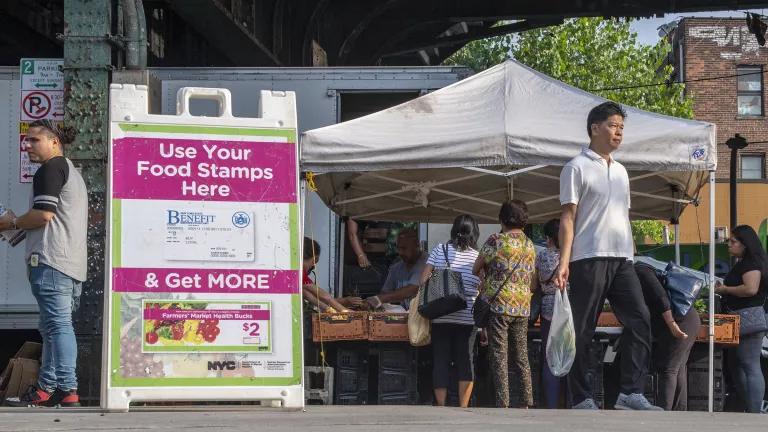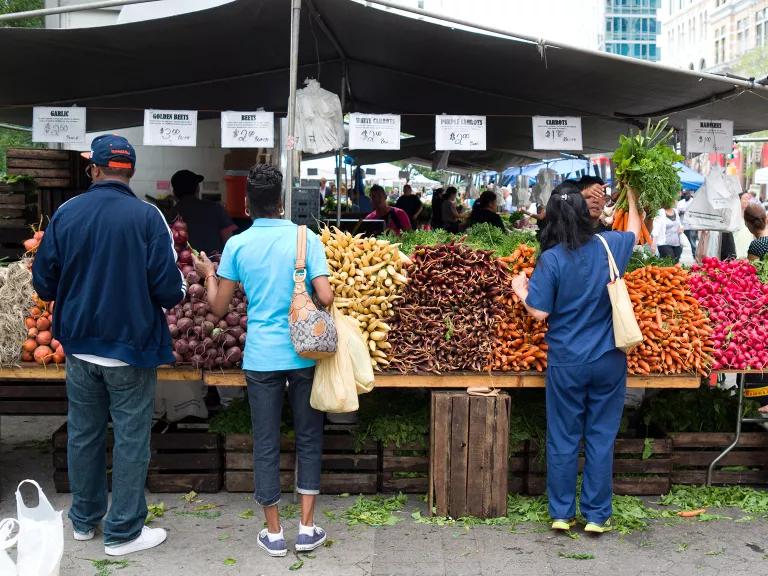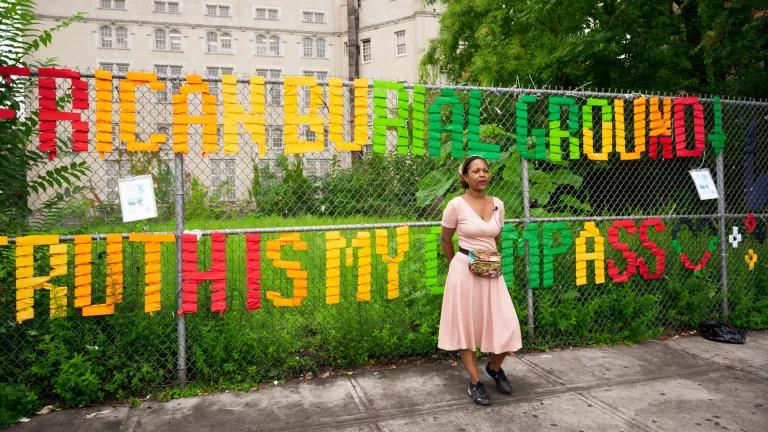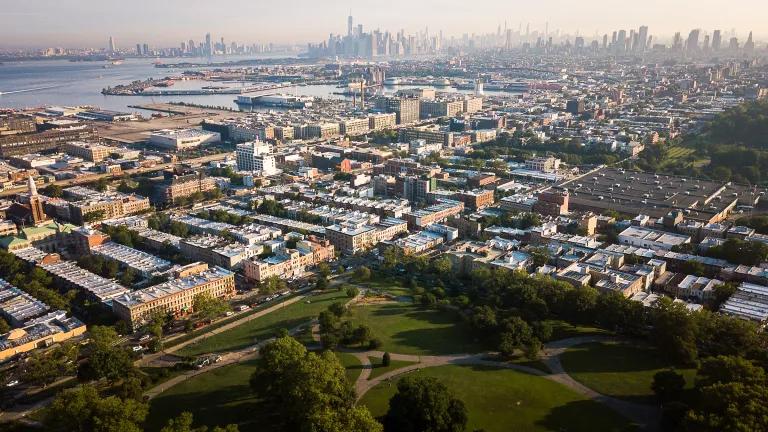
People shopping at Corona Farmers Market in Queens
Preston Keres/USDA
This blog is a companion to our previous post which shared an overview of SNAP incentives, the role these incentives play in addressing food insecurity, and some findings and themes from interviews with community members about SNAP and SNAP incentives in New York.
In this second post, we share quantitative data on geographic access to SNAP incentive locations in New York and five areas of improvement for these powerful incentive programs.
Broadly put, SNAP incentives offer SNAP shoppers extra money when they use their SNAP dollars to purchase certain kinds of food, often local fruits and vegetables. SNAP incentives have huge potential benefits for SNAP users, farmers, and local economies.
Through a series of interviews with community members about SNAP and SNAP incentives, we found that New Yorkers who use SNAP want to buy fresh, healthy foods and that the federal SNAP benefits are often not sufficient. We also heard that, although SNAP incentives offer a path to help bridge this gap, they are not meeting their full potential. Too many eligible beneficiaries are not aware of the programs and the programs can be cumbersome to use and administer.
In addition to this important qualitative data, we also mapped current SNAP incentive locations to get a better sense of whether New Yorkers using SNAP live close to places where they can take advantage of SNAP incentives.
Together, this data gives us a useful picture of where opportunities for improvement exist for SNAP incentives in New York.
Geographic Access to SNAP Incentives in New York
To get a rough sense of what percentage of households receiving SNAP benefits in New York do not live close to a SNAP incentive location, we mapped out the 382 locations that offer SNAP incentives across New York State, 136 of which are located within New York City. We defined households that “live close” to SNAP incentive locations as those that are located within a certain distance of at least one SNAP incentive location: within 1 mile for households in New York City and within 20 miles in the rest of the state, understanding that these distances are imperfect proxies. We then overlaid a map of SNAP households (i.e., households receiving federal SNAP benefits) on top of the map of the SNAP incentive locations and used the distances described above to count the SNAP households that live close to incentive locations.1
This analysis showed that 84.4% of SNAP households in New York City live close to a SNAP incentive location, and 93.9% of SNAP households in the rest of New York State live close to a SNAP incentive location.

The blue and orange dots on these maps depict SNAP incentive locations in New York City and in the remainder of New York state respectively. The blue shading on each map depicts the radius within which we have defined households as "living close” to a SNAP incentive location.
Maps by Isabel Friedman/NRDC
In total, 88.4% of SNAP households in New York live close to a SNAP incentive location, while 11.6% of SNAP households do not. This rough analysis suggests that New York has done a relatively successful job in providing most SNAP households with good geographic access to SNAP incentives.
This mapping exercise does not account for a number of physical and logistical limitations folks may face in reaching these SNAP incentive locations, including limitations related to transportation (e.g., lack of car, poor public transportation), schedules (e.g., work or care obligations that conflict with limited SNAP incentive location hours), and disability, among others.
Geographic proximity is not the only measure for physical access, but it does help us understand whether the number and location of current SNAP incentive outlets is a primary barrier to their use. Based on our findings above, while there is room for improvement, it doesn’t seem that physical distance is the primary barrier to accessing and using SNAP incentive programs for most New Yorkers.
Opportunities to Improve SNAP Incentives in New York
Major opportunities lie ahead for SNAP incentives in New York - with continued leadership needed from New York State. To better recognize the potential of SNAP incentives in New York, we must (1) adequately fund SNAP incentive programs, (2) move towards more consistency across the three existing programs that operate in New York, (3) address barriers to program awareness, (4) explore electronic payment systems and online availability, and (5) involve SNAP users and community-based organizations in any conversations or redesigns of these important programs.
Adequately Fund SNAP Incentive Programs
Robust and consistent state funding is essential to ensuring that SNAP incentives are available to as many New Yorkers as possible, thereby fully leveraging the federally funded SNAP program to benefit low-income families, farmers, and local economies.
The state has come a long way in increasing funding for SNAP incentive programs - from $625,000 in 2021 to $5,850,000 in 2023. That funding must remain consistent and should increase for the state to realize the huge benefits of these programs.
In the recent years of increased state funding, we’ve seen major advances in the two programs that received those funds - they have expanded in scope, benefits offered, and locations served.
The Fresh Connect Checks program increased the ratio of incentive they offer from $2 of incentive for every $5 of SNAP benefits spent to $2 of incentive for every $2 of SNAP benefits spent. This one-to-one ratio significantly strengthens the program and is consistent with New York City’s Health Bucks, Field and Fork’s Double Up Food Bucks, and most SNAP incentive programs in other states.
Field and Fork Network put their state funding to use piloting an innovative partnership with Tops Friendly Markets that allows SNAP shoppers to automatically receive incentives when using their SNAP benefits on eligible products. This pilot makes incentives available in a broader range of retailers and its automatic nature is a powerful way to address barriers to program awareness or enrollment, as discussed more below.
In addition to harnessing the federal SNAP benefits already pouring into New York by keeping SNAP dollars in local communities, state funding offers another opportunity to unlock federal dollars. Many SNAP incentive programs are, in part, funded through the Gus Schumacher Nutrition Incentive Program (GusNIP) which offers millions of dollars to these kinds of programs across the country through a competitive grantmaking process. One requirement of these significant grants is a 50/50 match of non-federal funds. Meaningful and consistent state funding allows programs in New York to unlock these important federal grants.

People shopping for fresh produce at the Union Square Greenmarket in Manhattan
Move Towards More Consistency Across Programs
There are three primary SNAP incentive programs that operate in New York – Field and Fork’s Double Up Food Bucks, New York City’s Health Bucks, and New York State’s Fresh Connect Checks. To the extent feasible, these three programs should be streamlined to reduce disparate experiences by farmers and customers using these programs. One major step towards this streamlining was the shift of the Fresh Connect Checks program from a 5:2 ratio of SNAP dollars spent to incentive dollars received to a 2:2 ratio, as described above. Further opportunities to make these three programs more similar to one another should be explored, and might benefit from the expertise of the Fair Food Network and other groups engaging with similar programs in other states.
Address Barriers to Program Awareness and Access
Far too many SNAP shoppers are not aware of the excellent SNAP incentive programs available in New York. As a result, they are leaving money for their families on the table.
There are at least two ways to address this challenge.
The first is to explore ways to automatically enroll SNAP users in SNAP incentive programs so they don’t have to know about the programs to take advantage of the benefits. This model has been used in other states, including Massachusetts, with great success. It is also part of the exciting partnership that Field and Fork Network is exploring with Tops Markets.
A second and complimentary idea is to invest further in public education and outreach to share these programs with SNAP users. This kind of educational campaign should be carefully designed with community-based organizations, SNAP users, and others who are familiar with current barriers to knowledge about the programs.
Explore Electronic Payment Systems and Online Availability
We heard from farmers and market managers that offering SNAP incentives through tokens or paper coupon systems can be quite cumbersome and challenging, especially during busy times at the market or when using more than one type of incentive. Many folks suggested putting the incentive directly onto SNAP shoppers’ existing EBT cards, something Massachusetts also does, and doing away with parallel coupon systems.
Finding ways for shoppers to use incentives to buy local foods online is also an important step in making these programs more accessible. Low-income shoppers should have access to the same variety of outlets (e.g., online retailers, online CSA systems, etc.) available to higher income New Yorkers.
Involve SNAP Users
Any efforts to reform, expand, or redesign SNAP incentive programs must include SNAP and SNAP incentive users. As we shared in our previous blog, SNAP users hold huge expertise on what does and does not work about these programs. They must be involved in any conversations to better fund and/or improve SNAP incentive programs moving forward. As a first step, New York State Department of Agriculture and Markets should reconvene the conversation around these important programs - one that first started in 2019 - and deliberately include and compensate community-based organizations and SNAP users.
This blog is the second and final post sharing themes and lessons learned from the Natural Resources Defense Council's research on SNAP and SNAP incentive programs in New York State over the past two years. We thank our consultants, QJM Multiprise and Five Points Geoplanning, plus many community members for their important insights that informed this work.
This blog provides general information, not legal advice. If you need legal help, please consult a lawyer in your state.
1 We gathered data on SNAP incentive locations from: Double Up Food Bucks New York; New York State Department of Agriculture & Markets; New York City Department of Health; and the Farmers Market Federation of New York. To map households in New York state that receive SNAP benefits, we used a 2021 dataset provided by ArcGIS.






